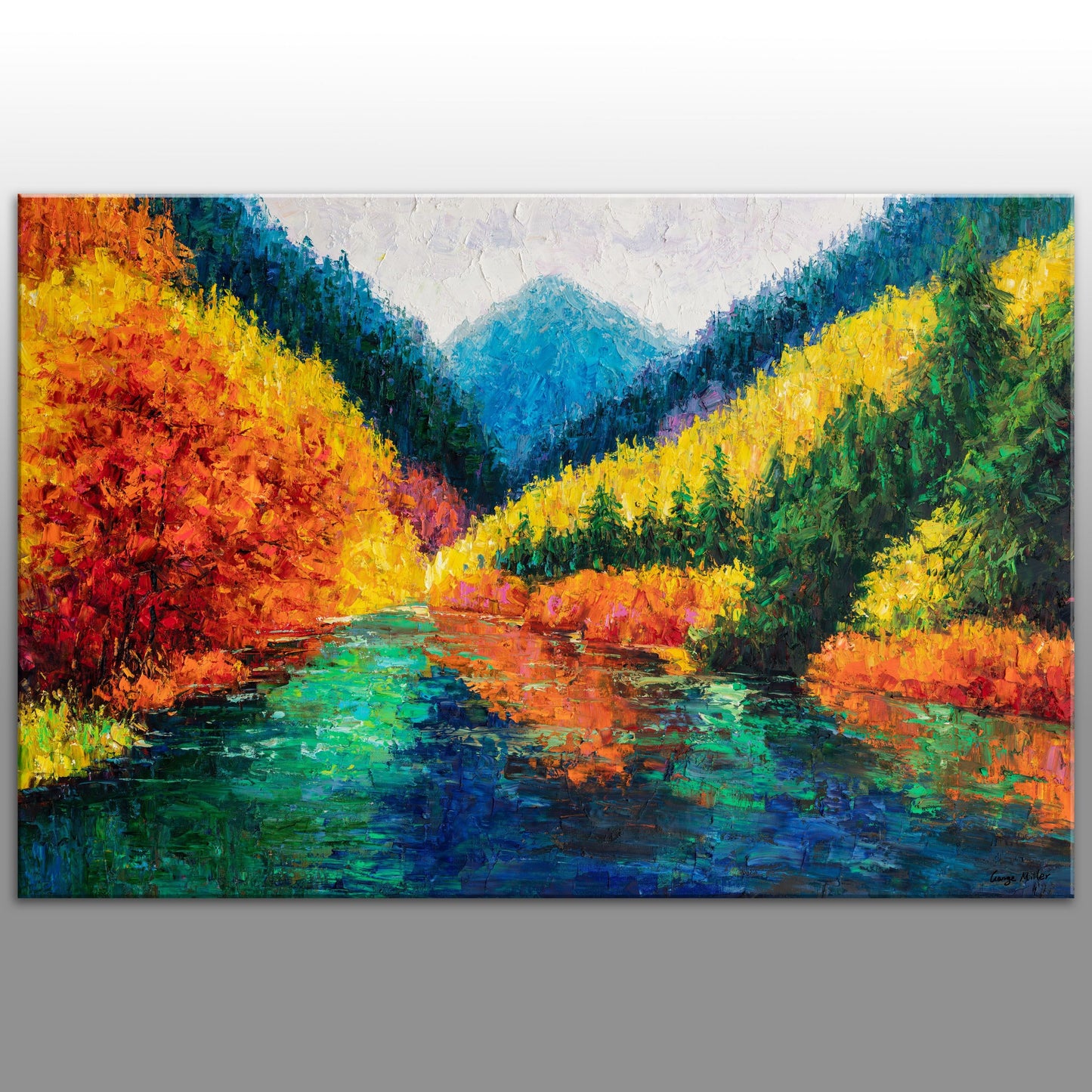The Benefits of Acquiring Oil Paintings: Why They Are a Timeless Financial investment
The advantages of buying oil paints extend past plain visual appeals. These art work carry historic significance and social value, making them worthwhile enhancements to any collection. Their distinct structures and techniques add to an engaging aesthetic experience. Additionally, established musicians often see their job appreciate in time, offering a prospective economic benefit - oil paintings for sale. As one discovers the complex reasons for buying oil paints, the deeper implications of such a choice ended up being increasingly evident
The Aesthetic Allure of Oil Paintings
The appeal of oil paintings depends on their lively shades and abundant textures, which can transform any area right into a fascinating environment. These art work have a deepness that captivates audiences, drawing them right into the intricacies of the brushstrokes and the interaction of light and darkness. The shiny coating of oil paint boosts the visual experience, providing life to scenes and subjects in such a way that other tools commonly can not attain. In addition, the selection of designs-- from classical to contemporary-- permits a diverse option that can complement any design. The emotional vibration shared via shade selections and techniques adds a layer of connection in between the observer and the art work, making oil paints not simply decorative items, however effective expressions of artistic vision.
Historic Importance and Cultural Value
Oil paints work as vital web links to a creative heritage, showcasing methods and styles that have actually progressed over centuries. They encapsulate cultural expressions and identifications, reflecting the values and stories of their time. By getting these works, people add to the conservation of history and the appreciation of diverse cultural heritages.
Imaginative Heritage Conservation
While several might forget the importance of imaginative heritage, buying oil paintings plays a vital role in preserving social and historical stories. These artworks function as visual documents of their time, catching the significance of societal worths, traditions, and historic events. By obtaining oil paintings, collectors add to the protecting of social legacies, guaranteeing that future generations can learn and value from these imaginative expressions. Each piece shows the special tale of its creator and the context in which it was made. In addition, the ongoing gratitude and display of oil paintings in different settings help to promote an understanding of varied artistic activities, enhancing the social landscape. As a result, purchasing oil paintings is not merely an economic decision but an act of cultural stewardship.
Cultural Expression and Identity
Art offers as a powerful medium for cultural expression and identity, reflecting the varied stories that form cultures. Oil paints, specifically, record the essence of cultural heritage, showing sociopolitical environments and historic contexts. Each brushstroke communicates emotions and stories distinct to specific customs, permitting visitors to engage with the musician's social history. This link fosters a sense of recognizing and belonging amongst various areas. In addition, oil paintings commonly offer as visual documents of social evolution, showcasing shifts in identity with time. The financial investment in these artworks not just sustains artists yet additionally protects social heritages, making them considerable assets for enthusiasts. Inevitably, oil paints enhance one's recognition for the complexities of human experience and the abundant tapestry of social identity.
Appreciation in Worth With Time

The admiration of oil paintings gradually is affected by various aspects, consisting of historic worth fads that reflect changing preferences and cultural significance. Furthermore, the online reputation of the artist plays a vital role in identifying the art work's market price, frequently increasing as the artist gains acknowledgment. Market need variations can better affect costs, making oil paints a potentially lucrative investment for enthusiasts.
Historic Worth Fads
As collection agencies look for to invest in substantial properties, the historic worth fads of oil paints reveal an engaging story of appreciation in time. Historically, oil paintings have demonstrated a regular higher trajectory in worth, specifically for works by established artists. Economic cycles and market need have actually affected these patterns, with periods of boosted rate of interest often leading to substantial price surges. Auction records often highlight the exceptional returns accomplished by renowned pieces, further reinforcing the idea of oil paints as viable long-lasting investments. Additionally, cultural movements and shifts in enthusiast choices have sometimes spurred unexpected appreciation, disclosing that the art market, while rather unforeseeable, typically favors high quality oil paints. Consequently, understanding these historic patterns can direct financiers in making educated choices.
Artist Reputation Effect
While the credibility of an artist plays a crucial function in the recognition of oil paintings, it is very important to acknowledge that this influence can vary substantially based on a number of factors. Developed musicians, particularly those with a considerable historical or social impact, have a tendency to see their jobs appreciate extra quickly. Alternatively, lesser-known or emerging artists might not experience the same level of need, affecting their artwork's value. In addition, the artist's capability to develop a consistent body of job and maintain significance in the art globe can influence lasting gratitude. Enthusiasts usually look for works from musicians who are acknowledged by credible galleries and institutions, which can better improve the worth of an oil paint with time, making artist online reputation a critical factor to consider in financial investment decisions.

Market Need Fluctuations
How do market demand variations influence the recognition of oil paints over time? The value of oil paintings is intrinsically linked to market demand, which can differ based on financial problems, fads, and collection agencies' choices. In times of financial prosperity, need usually increases, causing raised costs as even more buyers enter the market. Conversely, during economic slumps, need may diminish, creating worths to go stale or also decrease. In addition, the appeal of specific musicians can shift, affecting their job's worth. Inevitably, recognizing market need is important for financiers, as well-managed collections can value substantially with time, mirroring both the talent of the artist and the wider market characteristics. This interplay highlights the importance of strategic acquiring in oil paint investments.
Unique Structures and Strategies
Oil paintings astound customers with their distinct structures and methods, showcasing the artist's mastery over the tool. The thick application of paint, referred to as impasto, creates a three-dimensional effect, welcoming touch and improving visual deepness. Musicians often use different brush strokes, layering, and glazing techniques to accomplish luminous shades and detailed details. This flexibility permits abundant contrasts and refined shifts, making each art work distinctively expressive. Moreover, the sluggish drying time of oil paint enables musicians to blend shades effortlessly, resulting in smooth slopes and dynamic hues. These techniques add to the painting's overall personality, making it a compelling prime focus. Each oil paint acts as a sign of the creativity and skill fundamental in traditional artistic techniques.
Adaptability in Home Decoration
The unique structures and strategies of oil paintings not just display creative skill but additionally enhance their versatility in home decoration. These artworks can effortlessly enhance various interior styles, from modern-day minimal to conventional sophistication. Oil paints serve as focal factors, attracting focus and sparking conversation among visitors. Their abundant shades and deepness website can integrate with various color palettes, making them adaptable to altering style patterns. Additionally, the psychological vibration of oil paintings can create ambiance, whether it be warmth in a comfy living room or vibrancy in a creative work area. By integrating oil paintings, home owners boost their spaces, transforming them into thoughtfully curated settings that reflect personal taste and creative appreciation. Eventually, oil paints are a long-lasting choice for enhancing home visual appeals.
Connection to Distinguished Artists
While many art kinds can stimulate appreciation, acquiring oil paints frequently establishes a distinct connection to renowned musicians throughout background. Possessing an oil paint permits enthusiasts to involve with the imaginative visions of masters like Van Gogh, Monet, and Rembrandt. Each brushstroke personifies the artist's methods, intentions, and emotions, using insight into their globe. This connection transcends time, as each item carries a story that shows the cultural and historic context of its production. Enthusiasts not just obtain a job of art however likewise a fragment of the musician's tradition. As art enthusiasts explore the tales behind these paints, they get a deeper recognition for the workmanship and imaginative motions that shaped their growth, improving the value of their investment.
Psychological and Emotional Advantages of Art
Art frequently offers as a powerful stimulant for psychological and emotional health. The presence of oil paints in a space can stimulate a variety of emotions, from harmony to ideas. Their vibrant shades and intricate details provide visitors a retreat, enabling for representation and contemplation. Studies recommend that involving with art can decrease stress and anxiety and anxiety, fostering a sense of calmness. Furthermore, possessing initial art work can create a personal connection, enhancing feelings of satisfaction and delight. This psychological bond typically causes a deeper gratitude of one's environments, transforming a home into a home. Inevitably, the psychological advantages of art expand beyond aesthetics, contributing to total psychological health and improving life experiences.

Regularly Asked Concerns
Just how Do I Select the Right Oil Paint for My Room?
Selecting the best oil painting includes taking into consideration the area's color system, dimension, and total visual. One should review personal taste, the painting's emotional effect, and exactly how well it complements existing style prior to choosing.
What Variables Influence the Worth of an Oil Painting?
The worth of an oil paint is influenced by variables such as the musician's track record, provenance, historical significance, rarity, condition, and market need. Each aspect adds to overall worth and charm among collection agencies.
Just How Can I Take Care Of and Keep My Oil Paint?
To care for and maintain an oil paint, one ought to on a regular basis dirt it with a soft fabric, avoid straight sunlight direct exposure, control humidity levels, and think about specialist cleaning to maintain its vibrancy and stability.
Exist Particular Artists Known for Their Oil Paints?
Countless artists are renowned for their oil paints - oil paintings for sale. Remarkable numbers include Vincent van Gogh, Claude Monet, and Rembrandt, each commemorated for their unique methods and payments to the art world via dynamic, distinctive oil tools
Where Can I Acquisition Genuine Oil Paintings?
Authentic oil paintings can be purchased from trustworthy galleries, art fairs, and on-line systems concentrating on great art. Enthusiasts should verify the authenticity and provenance prior to buying to ensure a useful investment. Historically, oil paintings have actually shown a consistent higher trajectory in worth, especially for works by established musicians. While the online reputation of a musician plays an essential duty in the recognition of oil paintings, it is essential to recognize that this influence can differ significantly based on several variables. Oil paints captivate visitors with their unique textures and strategies, showcasing the artist's proficiency over the medium. While several art types can evoke adoration, buying oil paintings usually develops an unique connection to renowned artists throughout history. The worth of an oil painting is affected by factors such as the musician's reputation, provenance, historic value, condition, rarity, and market need.